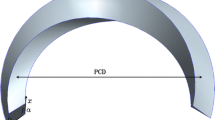Abstract
In this study, a multiphase CFD method is used to analyse fluid flow in a screw pump which rotates at very high angular velocity under cavitating conditions. This model utilizes a homogeneous phase approach, based on volume-scalar-equations and a truncated Rayleigh-Plesset equation for bubble dynamics. The model is implemented in the CFD software CFX. Three variants of screw pumps with different combinations of plain and threaded shrouds are studied for their Net Positive Suction Head (NPSH) required and compared. The three variants are studied under similar conditions, and the pump with maximum available NPSH is found out.
Access this chapter
Tax calculation will be finalised at checkout
Purchases are for personal use only
Similar content being viewed by others
References
Rayleigh L (1917) On the pressure developed in a liquid during the collapse of a spherical cavity. The London, Edinburgh, and Dublin Philosophical Magazine and Journal of Science. 34:94–98
Plesset M, Prosperetti A (1977) Bubble dynamics and cavitation. Annu Rev Fluid Mech 9:145–185
Chen Y, Heister SD (1996) Modeling hydrodynamic nonequilibrium in cavitating flows. ASME J Fluids Eng 118(1):172–178
Ahuja V, Hosangadi A, Arunajatesan S (2001) Simulations of cavitating flows using hybrid unstructured meshes. ASME J Fluids Eng 123(2):331–340
Athavale MM, Li HY, Jiang Y, Singhal AK (2002) Application of the full cavitation model to pumps and inducers. Int J Rotating Mach 8(1):45–56
Coutier-Delgosha O, Morel P, Fortes-Patella R, Reboud JL (2005) Numerical simulation of turbopump inducer cavitating behavior. Int J Rotating Mach 2005(2):135–142
Bakir F, Rey R, Gerber AG, Belamri T, Hutchinson B (2004) Numerical and experimental investigations of the cavitating behavior of an inducer. Int J Rotating Mach 10(1):15–25
Campbell GA, Sweeney PA, Felton JN (1992) Analysis of an alternative extruder screw pump design. J Int Polym Process 7(4):320–326
Li Y, Hsieh F (1996) Modeling of flow in a single screw extruder. J Food Eng 27:353–375
Alves MVC, Barbosa JR Jr, Prata AT (2009) Analytical solution of single screw extrusion applicable to intermediate values of screw channel aspect ratio. J Food Eng 92:152–156
Alves MVC, Barbosa JR Jr, Prata AT, Ribas FA Jr (2011) Fluid flow in a screw pump oil supply system for reciprocating compressors. Int J Refrig 34(1):74–83
Ma R, Wang K (2010) CFD numerical simulation and experimental study of effects of screw-sleeve fitting clearance upon triangular thread labyrinth screw pump (LSP) performance. J Appl Fluid Mech 3(1):75–81
Ma R, Wang K (2009) Modeling of pumping performance of labyrinth screw pump (LSP) by 2D Reynolds stress equations. ASME J Fluids Eng 131(8):085001
Philip J, Suryan A, Sanand TV, Unnikrishnan Nair P (2016) Flow analysis of a screw pump in the turbo pump of a semi-cryogenic engine. In: Proceedings of LAMSYS 2016, Sriharikota
Philip J, Suryan A, Sanand TV, Unnikrishnan Nair P (2017) Computational study on the influence of number of threads on the performance of single screw pump at high angular velocities. J Therm Sci 26(1):54–59
ANSYS CFX-Solver, Theory Guide
Menter FR (1994) Two-equation eddy-viscosity turbulence models for engineering applications. AIAA J 32(8):1598–1605
Liuzzi D (2012) Two-phase cavitation modelling, PhD Dissertation, University of Rome – LA SAPIENZA
Author information
Authors and Affiliations
Corresponding author
Editor information
Editors and Affiliations
Rights and permissions
Copyright information
© 2018 Springer International Publishing AG, part of Springer Nature
About this chapter
Cite this chapter
Philip, J., Suryan, A., Sanand, T.V., Unnikrishnan Nair, P. (2018). Computational Study on the Design for Fluid Flow in High Angular Velocity Screw Pumps. In: Nižetić, S., Papadopoulos, A. (eds) The Role of Exergy in Energy and the Environment. Green Energy and Technology. Springer, Cham. https://doi.org/10.1007/978-3-319-89845-2_19
Download citation
DOI: https://doi.org/10.1007/978-3-319-89845-2_19
Published:
Publisher Name: Springer, Cham
Print ISBN: 978-3-319-89844-5
Online ISBN: 978-3-319-89845-2
eBook Packages: EnergyEnergy (R0)



